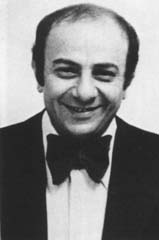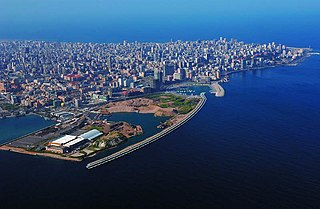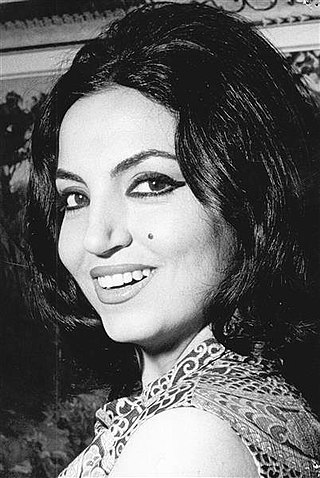Related Research Articles

Beirut is the capital and largest city of Lebanon. As of 2014, Greater Beirut has a population of 2.5 million, which makes it the third-largest city in the Levant region and the thirteenth-largest in the Arab world. The city is situated on a peninsula at the midpoint of Lebanon's Mediterranean coast. Beirut has been inhabited for more than 5,000 years, making it one of the oldest cities in the world.

Nouhad Wadie Haddad, known as Fairuz, is a Lebanese singer. She is considered by many as one of the leading vocalists and most famous singers in the history of the Arab world. Fairuz is considered the musical icon of Lebanon and is popularly known as "the soul of Lebanon".

Warda Al-Jazairia was an Algerian singer. She was well known for her Egyptian Arabic songs and music. Her name was sometimes shortened to just Warda or as "The Algerian rose" in the Arab world.

Heinz Bongartz was a German conductor and composer. He was the first artistic manager of the Dresdner Philharmonie under the East German regime. He headed the orchestra's first tour to the Middle East in January 1967 which began in Beirut, Lebanon. After performing at Beirut's Piccadilly Theatre they performed the first of three concerts at the Cairo Opera House on 8 June. The tour also included performances in Alexandria.

The Rahbani brothers, Assi Rahbani and Mansour Rahbani were Lebanese sibling musicians, composers, songwriters, authors, and playwrights/dramatists, best known for their work with the singer Fairuz, Assi's wife. Their younger brother Elias Rahbani was also a famous lyricist and composer.
Joseph Philippe Karam (1923–1976) was a Lebanese architect. He was a leading figure of modern architecture in Lebanon during the country's golden era, 1945 to 1975. Karam founded his practice the Atelier d'Architecture Joseph Philippe Karam in the late 1940s.
Rue Clemenceau is a commercial and residential street in Beirut, Lebanon. The street was named in honor of Georges Clemenceau who accepted the post of premier of France in 1917 during World War I. The neighborhood straddling Clemenceau Street was prior to the war one of the most cosmopolitan areas of the city and home to Christians, Muslims, Druze and Jews.

Bliss Street, or Rue Bliss, is one of the principal streets of the Hamra area, which is within the Ras Beirut District of Beirut in Lebanon. The street, which is parallel to Hamra Street, runs east-west, connecting with Rue Clémenceau on the east and ending at Avenue General Charles de Gaulle that runs along the coast of the Mediterranean.

Hamra Street or Rue Hamra is one of the main streets of the city of Beirut, Lebanon, and one of the main economic and diplomatic hubs of Beirut. It is located in the neighborhood of the same name, Hamra. Its technical name is Rue 31. Due to the numerous sidewalk cafes and theatres, Hamra Street was the centre of intellectual activity in Beirut during the 1960s and 1970s. Before 1975, Hamra Street and the surrounding district was known as Beirut's trendiest, though in the post-war period it has arguably been eclipsed by Rue Monot in Ashrafieh, Rue Gouraud in Gemmayzeh, Rue Verdun, and downtown area. In the mid 1990s, the Municipality of Beirut gave a facelift to the street to reattract tourists all year round. Hamra Street was known as Beirut's Champs Elysées, as it was frequented by tourists all year round.

The Beirut Nights are numbers of events that take place from time to time in Beirut, Lebanon. It's usually active in the summer; however, some other festivals might happen in spring or fall. Beirut Central District has been chosen for many times to hold such occasions whereas others preferred to have their "nights" in exquisite bars and nightclubs. The city is known of its huge crowd from different nationalities participating in these events. Over the years, Beirut witness many concerts or performances that include classical music, dance, theatre, opera, jazz, and modern world music.

The Toilers League, also designated the Workers League is a Lebanese left-wing political party founded in Lebanon at the late 1960s and currently led by former Chouf MP Zaher el-Khatib.

Lydia Canaan is a Lebanese singer-songwriter and humanitarian activist widely regarded as the first rock star of the Middle East. She is cataloged in the Rock and Roll Hall of Fame and Museum's Library and Archives.

Rue Monnot, is a street in Beirut, Lebanon. It is located east of Beirut Central District, in the Sodeco neighborhood of the Achrafieh district, and named after Father Ambroise Monnot, a French Jesuit who founded the Saint Joseph University of Beirut in 1875.

Elissar Zakaria Khoury, commonly known as Elissa, is a Lebanese singer. She is one of Lebanon's most famous singers, and one of the best-known artists in the Arab world.
Theatre in Lebanon has its origin in passion plays. The musical plays of Maroun Naccache from the mid-1800s are considered the birth of modern Arab theatre. Some scholars, such as Abdulatif Shararah, have divided Lebanese theatre into three historical phases centered on 1) translations of European plays, 2) Arab nationalism, and 3) realism.
Rue John Kennedy is a street in Beirut, Lebanon. The street, originally called Rue Perthuis, was renamed in honor of President John F. Kennedy on November 30, 1963. The street, which is located in the Ras Beirut district of the Lebanese capital, is a one-way street that runs east–west from Rue de Phénicie, past Rue Nicolas Rebeiz and Rue Van Dyck, and then curving to the south along the campus walls of the American University of Beirut until it reaches Rue Clémenceau where it ends. It is primarily a residential street with some small hotels.

Samira Ghastin Karimona, better known by her stage name Samira Toufic is a Lebanese-Jordanian singer who gained fame in the Arab world for her specializing in singing in the Bedouin Shawi Arabic.
Le Commodore Hotel Beirut, also known as the Beirut Commodore Hotel, Hotel Commodore, or simply the Commodore is a five-star luxury hotel located on Rue Baalbek in the Hamra district of Beirut in Lebanon.

Pierre Jamjian was a Lebanese-Armenian actor, who began his artistic career on stage during the early 70s, and then moved to television, where he became famous in Lebanon after participating with the artists Ibrahim Maraachli and Hend Abi Al-Lama in the comedy series The Teacher and the Professor in which he played the character “Piaro”.

Takla Chamoun Farjallah is a Lebanese actress, drama instructor, producer, and the co-founder and CEO of the Lebanese Film Academy. Chamoun is highly regarded in the Middle East and the Arab World for her acting and her ability to mold into a character.
References
- ↑ Kamel, Lojine (11 October 2012). "Piccadilly Theatre: Beirut Treasure in Ruins".
- ↑ Keuchkerian, Karine (26 July 2022). "Lebanese Iconic Piccadilly Theatre Will Be Restored After Closing For 40 Years". 961. Retrieved 17 October 2022.
- ↑ Kelly, Elaine (2019). "Performing Diplomatic Relations: Music and East German Foreign Policy in the Middle East during the Late 1960s" (PDF). Journal of the American Musicological Society . 72 (2): 494. doi:10.1525/jams.2019.72.2.493. JSTOR 26855885. S2CID 192475023.